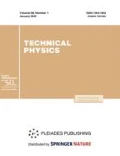Abstract
In this paper, we propose a method for optimizing the design and composition of the anode membrane with a transmission-type target as part of a system of soft X-ray sources based on field-emission triodes for performing tasks in the field of X-ray nanolithography. It allows to prevent the degradation of the operating characteristics of the system when significant electrostatic deformation of the anode occurs under the influence of a control electric field in the inter-electrode space of the triodes. For this purpose, the inclusion of an additional control electrode in the system design is considered, which makes it possible to compensate for the deformation of the anode membrane to an acceptable level and thereby stabilize the operation of X-ray sources. A numerical model of the electrostatic deflection of the anode assembly in a modified design is developed, based on which the optimal composition and geometric parameters of the anode membrane with a compensating electrode are determined. In particular, the optimal distance between the anode membrane in the initial (undeformed) state and the compensating electrode was found (equal to 5 μm), at which a minimum voltage difference (about 1.15 kV) should be applied to these electrodes to prevent critical deflection of the membrane (0.72 μm with a membrane radius of 750 µm). It is also shown that, due to their extremely high hardness (>80 GPa), diamond-like films are the most promising material for the anode electrode. The results obtained can also be useful for the development of miniature X-ray generation devices for various applications.





Similar content being viewed by others
REFERENCES
J.-W. Han, M.-L. Seol, D.-I. Moon, G. Hunter, and M. Meyyappan, Nat. Electron. 2, 405 (2019). https://doi.org/10.1038/s41928-019-0289-z
M. Liu, T. Li, and Y. Wang, J. Vac. Sci. Technol., B 35, 031801 (2017). https://doi.org/10.1116/1.4979049
Y. Huang, Z. Deng, W. Wang, C. Liang, J. She, S. Deng, and N. Xu, Sci. Rep. 5, 10631 (2015). https://doi.org/10.1038/srep10631
S. A. Guerrera and A. I. Akinwande, Nanotechnology 27, 295302 (2016). https://doi.org/10.1088/0957-4484/27/29/295302
P. Zhang and Y. Y. Lau, J. Plasma Phys. 82 (5), 595820505 (2016). https://doi.org/10.1017/S002237781600091X
W.-T. Chang, H.-J. Hsu, and P.-H. Pao, Micromachines 10, 858 (2019). https://doi.org/10.3390/mi10120858
J.-W. Han, D.-I. Moon, and M. Meyyappan, Nano Lett. 17, 2146 (2017). https://doi.org/10.1021/acs.nanolett.6b04363
J. Xu, Z. Gu, W. Yang, Q. Wang, and X. Zhang, Nanoscale Res. Lett. 13, 311 (2018). https://doi.org/10.1186/s11671-018-2736-6
M. Liu, Y. Lei, Y. Yang, T. Li, and Y. Wang, Proc. Int. Conf. Manipulation, Automation and Robotics at Small Scales (Helsinki, Finland, 2019), Vol. 1. https://doi.org/10.1109/marss.2019.8860991
N. A. Djuzhev, G. D. Demin, T. A. Gryazneva, V. Yu. Kireev, and D. V. Novikov, IEEE Conf. of Russian Young Researchers in Electrical and Electronic Engineering (EIConRus) (Moscow, Russia, 2018), p. 1974. https://doi.org/10.1109/EIConRus.2018.8317498
N. Egorov and E. Sheshin, Field Emission Electronics (Springer, 2017), Vol. 60. https://doi.org/10.1007/978-3-319-56561-3
E. M. Sebastian, S. K. Jain, R. Purohit, S. K. Dhakad, and R. S. Rana, Mater. Today (in press). https://doi.org/10.1016/j.matpr.2020.02.505
N. I. Chkhalo, A. Ya. Lopatin, A. E. Pestov, N. N. Salashchenko, G. D. Demin, N. A. Dyuzhev, and M. A. Makhiboroda, Proc. SPIE 11022, 110221M (2018). https://doi.org/10.1117/12.2522105
C. Xue, J. Zhao, Y. Wu, H. Yu, S. Yang, L. Wang, W. Zhao, Q. Wu, Z. Zhu, B. Liu, X. Zhang, W. Zhou, and R. Tai, Appl. Surf. Sci. 425, 553 (2017). https://doi.org/10.1016/j.apsusc.2017.07.010
N. A. Djuzhev, G. D. Demin, T. A. Gryazneva, A. E. Pestov, N. N. Salashchenko, N. I. Chkhalo, and F. A. Pudonin, Bull. Lebedev Phys. Inst. 45 (1), 1 (2018). https://doi.org/10.3103/S1068335618010013
N. I. Tatarenko and V. F. Kravchenko, Autoemission Nanostructures and Devices Based on Them (Fizmatlit, Moscow, 2006) [in Russion].
N. A. Djuzhev, G. D. Demin, N. A. Filippov, I. D. Evsikov, P. Y. Glagolev, M. A. Makhiboroda, N. I. Chkhalo, N. N. Salashchenko, S. V. Filippov, A. G. Kolosko, E. O. Popov, and V. A. Bespalov, Tech. Phys. 64 (12), 1742 (2019). https://doi.org/10.1134/S1063784219120053
N. N. Salashchenko, N. I. Chkhalo, and N. A. Djuzhev, J. Surf. Invest.: X-Ray, Synchrotron Neutron Tech. 12, 944 (2018). https://doi.org/10.1134/S1027451018050324
G. D. Demin, N. A. Djuzhev, N. A. Filippov, P. Yu. Glagolev, I. D. Evsikov, and N. N. Patyukov, J. Vac. Sci. Technol., B 37, 022903 (2019). https://doi.org/10.1116/1.5068688
COMSOL Multiphysics v. 5.5, COMSOL AB (Stockholm, Sweden), https://www.comsol.com/
M. Ding, G. Sha, and A. I. Akinwande, IEEE Trans. Electron Devices 49, 2333 (2002). https://doi.org/10.1109/TED.2002.805230
R. Hatada, S. Flege, M. N. Ashraf, A. Timmermann, C. Schmid, and W. Ensinger, Coatings 10, 360 (2020). https://doi.org/10.3390/coatings10040360
S. L. Shinde and J. Goela, High Thermal Conductivity Materials (Springer, 2006). ISBN: 9780387251004
Funding
This work was supported by Russian Federation Presidential Council for Grants (grant no. 075-15-2019-1139) and carried out using the equipment of MIET Core facilities center “MEMS and electronic components” supported by the Ministry of Education and Science of the Russian Federation.
Author information
Authors and Affiliations
Corresponding author
Ethics declarations
The authors declare that they have no conflicts of interest.
Additional information
Translated by E. Chernokozhin
Rights and permissions
About this article
Cite this article
Glagolev, P.Y., Demin, G.D., Oreshkin, G.I. et al. Optimization of an Anode Membrane with a Transmission-Type Target in a System of Soft X-Ray Sources for X-Ray Nanolithography. Tech. Phys. 65, 1709–1716 (2020). https://doi.org/10.1134/S1063784220110122
Received:
Revised:
Accepted:
Published:
Issue Date:
DOI: https://doi.org/10.1134/S1063784220110122



